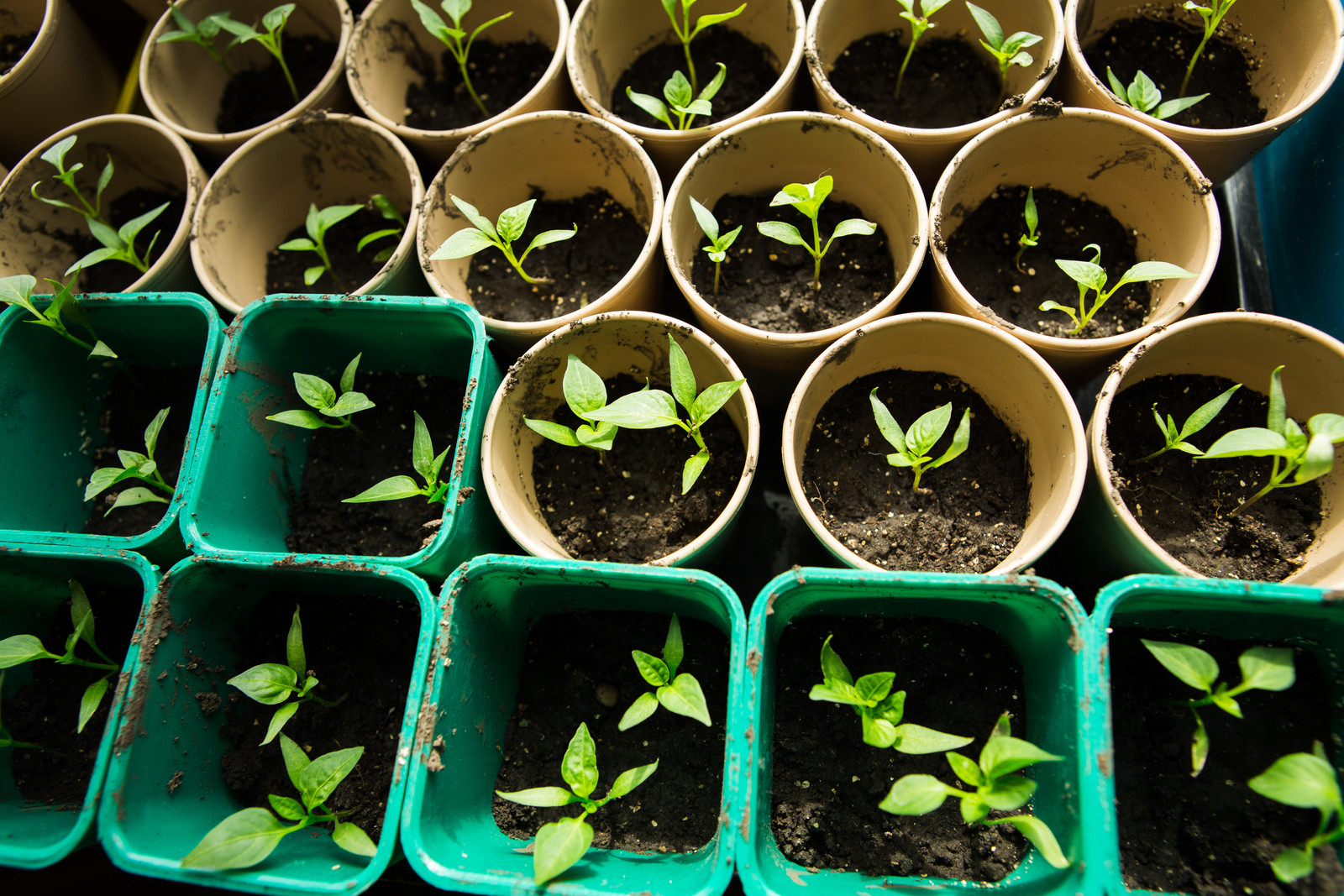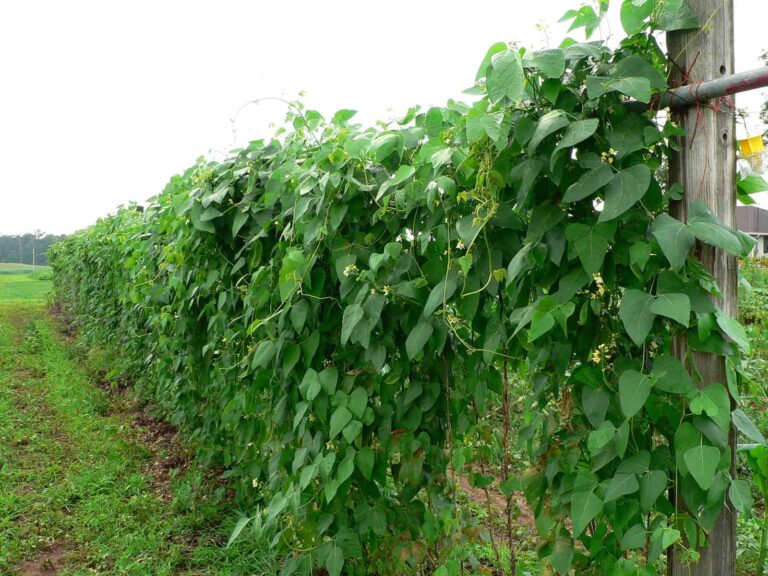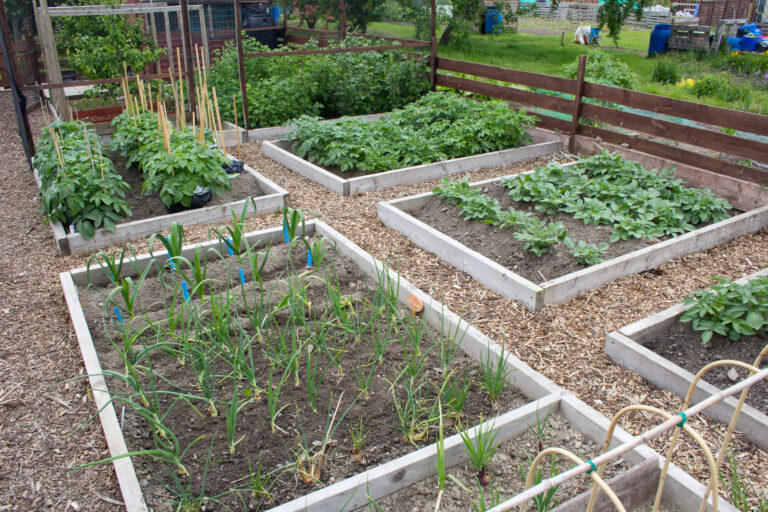Starting Vegetables Indoors: 15 Varieties for Success
Starting vegetable seeds indoors will give you a head start on the growing season–extend your growing season–and make your garden more productive.
Starting seeds indoors eliminates one of the biggest unpredictables of vegetable gardening–poor outdoor germination conditions. Light, temperature, water, nutrients, and spacing are planned and regulated indoors; seeds find it much easier to grow into edible plants.
Starting seed indoors also will widen your choices. Many, many rare, unusual, and tasty vegetable varieties are available from seed, many more than are offered as starts in garden centers and nurseries.
Tomatoes, peppers, eggplant, cabbage, broccoli, cauliflower, Brussels sprouts, onions, and celery are almost always started indoors. These plants require the time and care to get going that the gardener can offer indoors. Cold climate gardeners will often also start lettuce and squashes indoors.
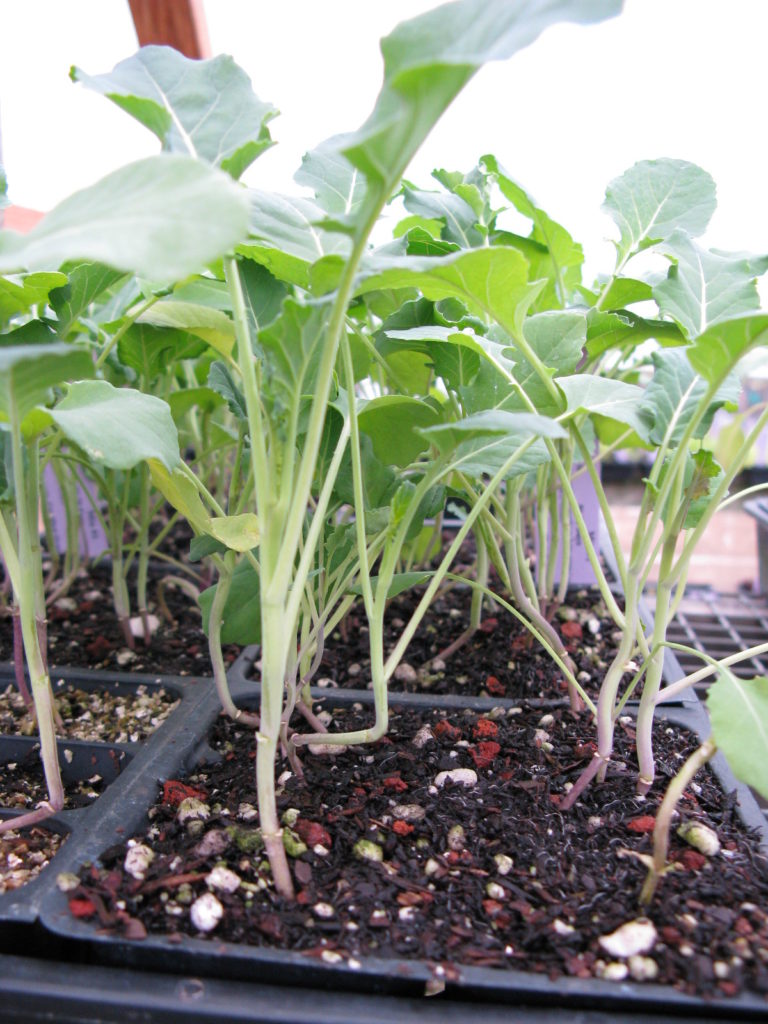
15 vegetables to seed start indoors
Broccoli
Broccoli is a cool-season crop to grow in spring–or fall. Start spring crops in individual pots 6 to 8 weeks before the last expected frost date. Sow seeds ¼ inch deep in individual peat pots. Keep the soil moist, but not wet. The seed should germinate in 10 days at 70°F. Transplant the seedlings into the garden when they are about 6 inches tall, with two to four leaves, not earlier than 2 to 3 weeks before the last frost. The optimal garden growing temperature is 50° to 60°F. Broccoli grows best in cool, moist conditions. Broccoli will be ready for harvest 50 to 60 days after transplanting to the garden. Direct seed fall crops in midsummer.
Brussels sprouts
Brussels sprouts are commonly grown as a fall crop in cold-winter regions and as a fall and winter crop in frost-free regions. Check the seed packet for the days to maturity, then count back that number of days from your first expected frost. Start seeds 12 to 16 weeks before that date. Sow seeds ½ inch deep in individual peat pots. The seeds should germinate in 10 days at 70°F. Harden off seedlings before setting them in the garden. Set transplant with the bottom leaves just above the soil. Brussels sprouts grow best at temperatures between 50° and 60°F and will be ready for harvest 75 to 95 days after sowing.
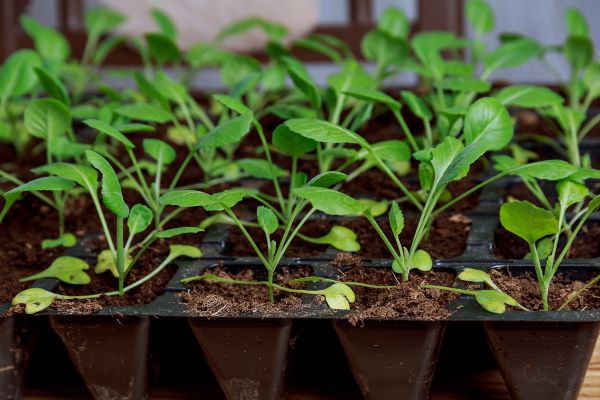
Cabbage
Cabbage is a cool-weather crop that can be grown in spring or fall. Sow seeds ¼ inch deep and 2 inches apart in cell packs or flats, about 5 to 7 weeks before the last expected frost date. The seeds will germinate in 10 to 14 days at 70°F. About 2 to 3 weeks before the last frost when seedlings have three leaves and daytime temperatures reach 50°F, transplant cabbage outdoors. Set transplants slightly deeper than they grew indoors. Cabbage grows best in temperatures between 50° and 60°F and will be ready for harvest 40 to 90 days after transplanting to the garden. Mid- and late-season varieties can be either direct-seeded in midsummer or started indoors.
Cauliflower
Cauliflower is a cool-weather crop that can be grown in spring or fall. Sow seeds ¼ to ½ inch deep and 2 inches apart in cell packs or flats or in individual pots. Sow cauliflower indoors 8 to 10 weeks before the last frost. The seeds will germinate in 10 to 14 days at 70° to 75°F; bottom heat is best. Set the pots in bright light and provide even moisture. Seedlings can be transplanted into the garden about 2 to 3 weeks before the last frost. Cauliflower grows best in temperatures between 50° and 60°F and will be ready for harvest in 45 to 70 days. A second crop can be sown directly into the garden 12 to 14 weeks before the first fall frost.
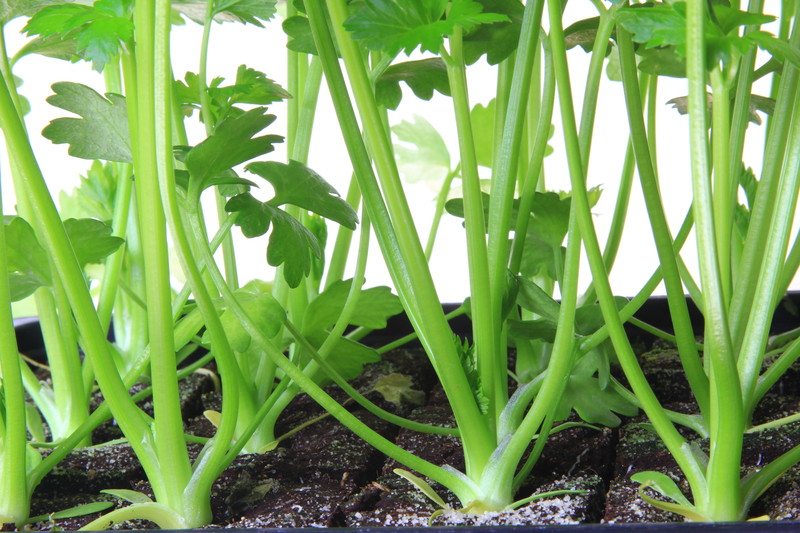
Celery
Celery is a long-season, cool-climate crop. It prefers an average growing on temperature of 60°F. For a late summer crop, sow celery indoors 10 to 12 weeks before the last frost in spring. Sow seeds ⅛ inch deep in rows 1 inch apart. Sow seed in flats or individual containers. Cover the seed lightly with a moist seed-starting mix. Place a damp horticultural cloth over the seed-starting trays or containers until the seeds sprout. The seeds will germinate in 21 to 25 days at 70° to 75°F. When seedlings are about 4 inches tall, transplant them into individual peat or newspaper pots. When they are 6 inches tall, harden them off and transplant them to the garden. Keep the soil moist throughout the growing season and fertilize plants with compost tea every 2 weeks. Celery requires 80 to 140 days to reach harvest.
Cucumbers
Cucumbers are a warm-weather crop. Sow cucumbers 4 to 6 weeks before the last frost in spring for setting out in the garden two weeks after the last frost. Sow seeds 1 inch deep in seed starting mix in individual biodegradable pots. Seeds will germinate in 7 to 10 days at 70°F. Transplant the entire pot into the garden so as not to disturb the roots. Be sure that the top of the peat pot is well below the soil line otherwise it will act as a wick and dry out the pot, making it difficult for tender young roots to break through. Keep the soil moist and cool and fertilize the plants with compost tea every 4 weeks. Cucumbers prefer an average growing on temperature of 60° to 65°F or slightly warmer. They require 48 to 70 days to reach harvest.

Eggplant
Eggplant is a warm-weather crop. Start seed indoors 6 to 8 weeks before the average last frost date in spring. Sow seeds ¼ inch deep into individual peat or newspaper pots. Seeds will germinate in 7 to 14 days at 75° to 80°F. Use bottom heat to maintain soil temperature until the seeds germinate. Seedlings can be transplanted outdoors when nighttime temperatures consistently exceed 50°F and the soil warms to at least 70°F. Place black plastic over the rows to warm the soil before planting and alongside the plants during the growing season. Transplant the entire pot into the garden so as not to disturb the roots. Be sure that the top of the peat pot is well below the soil line otherwise it will act as a wick and dry out the pot, making it difficult for the roots to break through. Keep the soil evenly moist. Eggplant requires 54 to 80 days from transplanting to reach harvest.
Florence fennel
Florence fennel is a warm-weather crop. Sow seed indoors 2 to 4 weeks before the average last frost date in spring. Sow seed ¼ inch deep. The seeds will germinate in 7 to 14 days at 65° to 75°F. Transplant the seedlings to the garden when they have two or more true leaves. Florence fennel prefers a growing on soil temperature of 65°F. Keep soil evenly moist and feed plants compost tea every 4 to 5 weeks. Fennel requires 90 to 115 frost-free days from sowing to reach harvest. Sow Florence fennel indoors or in the garden at least 8 weeks before the first frost in fall for an autumn crop. Protect the autumn crop from freezing weather.
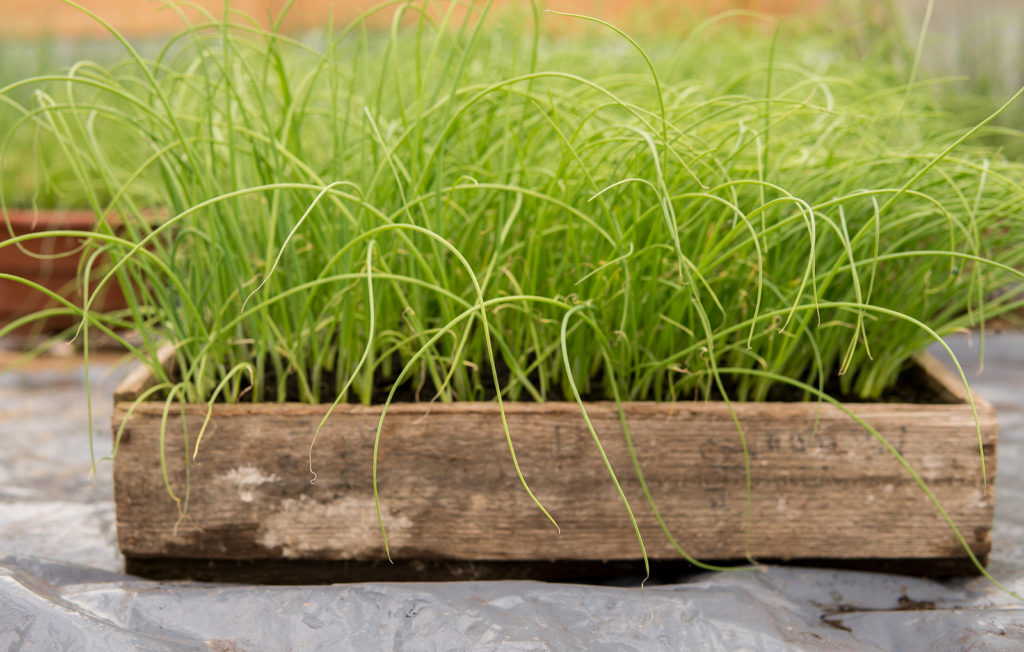
Leeks
Leeks are a long-season, cool-climate crop. In hot summer, mild winter regions grow leek as a winter crop in mild-winter regions. Leek is best started indoors 8 to 12 weeks before the average last frost date. Sow seeds ¼ inch deep and 1 inch apart in flats or containers. Leeks germinate in 8 to 16 days at 75°F. Keep seed-starting containers at a temperature of 65°F to 70°F during the day and 55° to 60°F at night. At least 1 week after the last frost, when seedlings are about 6 to 8 inches tall, transplant them to the garden. Transplant them into 5- or 6-inch-deep drills so that leaf tips are just 1 or 2 inches above the surface. As leaves grow, draw the soil up around the stems to blanch and keep them tender. Leeks will be ready for harvest in 120 to 170 days.
Lettuce
Lettuce is a cool-season crop best grown in spring and fall when summers are very warm. Lettuce grows best at temperatures between 60° and 65°F. Begin early spring crops indoors 4 to 6 weeks before the last frost date. Sow seed ⅛ to ¼ inch deep, just lightly covered with starting mix. Seeds will sprout in 7 to 10 days at 70°F. Thin seedlings in flats to 4 inches apart. Transplant lettuce to the garden when leaves are 4 or 5 inches tall and the soil is workable. Set out seedlings successively until mid-spring when temperatures consistently reach 75° to 80°F. Lettuce will bolt to seed in warmer temperatures. Begin sowing lettuce again in midsummer for a fall harvest that can continue until the first frost.
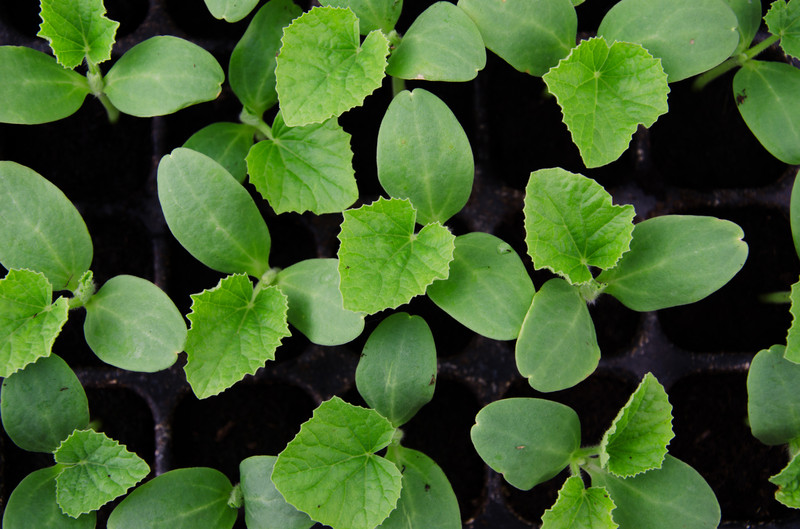
Melons
Melons are a warm-weather crop. Sow seed indoors 2 to 4 weeks before the last frost in spring. Melons can be transplanted into the garden two or more weeks after the last frost. Do not sow melons too early before transplanting: seedlings that develop more than four leaves before transplanting may have trouble establishing roots. Sow several seeds ½ inch deep in each 4-inch peat or biodegradable pot. Seeds germinate in 6 to 10 days at temperatures between 75°F and 80°F; use bottom heat if necessary. Thin seedlings when they reach 2 inches tall, leave only the strongest plant in each pot. Transplant seedling, pot and all, when all danger of frost has passed and garden soil has warmed to at least 70°F. Place the top of the peat pot below the soil line, otherwise, it will act as a wick and dry out the pot, and new roots will have a difficult time breaking through. Muskmelons, cantaloupes, and summer melons require 70 to 90 to reach harvest. Casaba, honeydew, and other summer melons require 90 to 110 days to reach harvest.
Onions
Onions are planted in cool weather. Green onions and scallions are harvested before bulbs form, usually in cool weather. Bulb onions come to maturity in warm weather and can be harvested as many as 300 days after sowing. Sow onion seeds in cell packs or flats about 8 to 10 weeks before the last expected frost in spring. Sow seed ¼ inch deep, about four seeds per inch. The seeds will sprout in 10 to 14 days at 70°F. Transplant seedlings to the garden from early to mid-spring after the soil can be worked. Onions prefer a growing on temperature of 60°F or warmer. Onions can be set in the garden as early as 4 weeks before the last frost in spring. If seedlings grow tall and gangly before transplanting, cut them back a couple of inches to encourage them to become stocky. Bulb onions require 95 to 300 days to reach harvest. Green onions and scallions can be harvested in half those days.
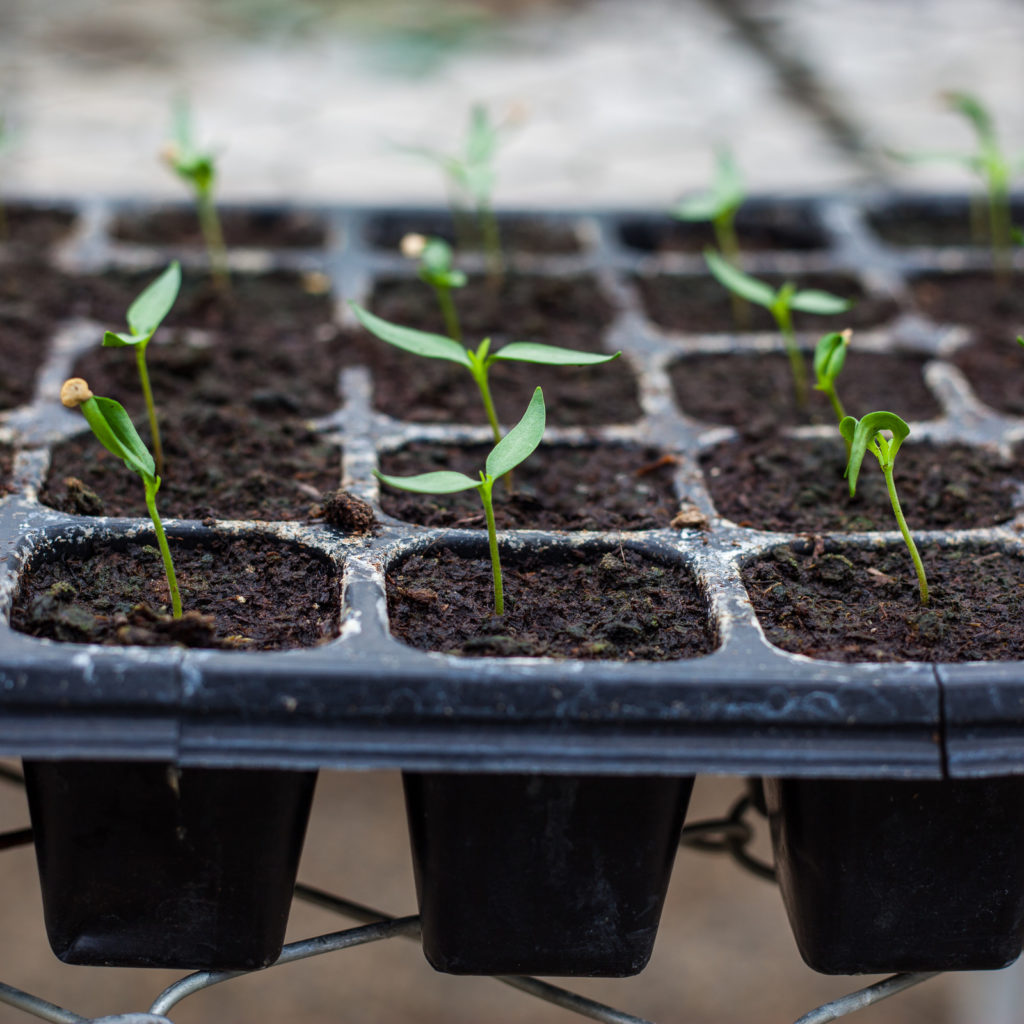
Peppers
Peppers are a warm-weather crop that requires a long growing season. Sow seeds indoors 8 to 10 weeks before the last frost date in spring. Sow two or three seeds in a biodegradable pot, ¼ inch deep. Seed germinates in about 10 days at 75° to 80°F. Grow seedlings on at a soil temperature of about 75°F and keep the soil moist but not wet. Thin to the strongest plant in each pot when seedlings are 2 to 3 inches tall. Transplant seedlings to the garden pot and all 2 to 3 weeks after the last frost in spring after seedlings have grown to 4- to 6-inches tall. Peppers grow best when nighttime temperatures remain about 55°F and daytime temperatures are 65°F or greater. Keep seedlings and plants evenly watered. Peppers reach maturity 60 to 95 days after transplanting to the garden.
Squash
Squash is a warm-weather crop that requires 48 to 110 days to reach maturity depending upon variety. Sow squash 4 to 6 weeks before the last frost in spring, particularly in regions with a short growing season. Sow 2 seeds ½ to 1 inch deep in each peat pot or soil block. The seeds will germinate in 7 to 10 days at 70°F. Thin to the strongest seedling in each pot after seedlings have grown their first true leaves. Transplant seedlings and pot to the garden 1 to 2 weeks after the last frost in spring when the soil temperature has warmed to at least 60°F. Water seedlings well before transplanting. Place the pot below soil level so that the pot will decompose as roots grow. Summer squash (crookneck, zucchini, patty pan, and soft-skinned squashes) require 50 to 70 days to reach harvest. Winter squash (acorn, butternut, cushaw, spaghetti, Hubbard, and hard-skinned squashes) require 90 or more days to reach harvest
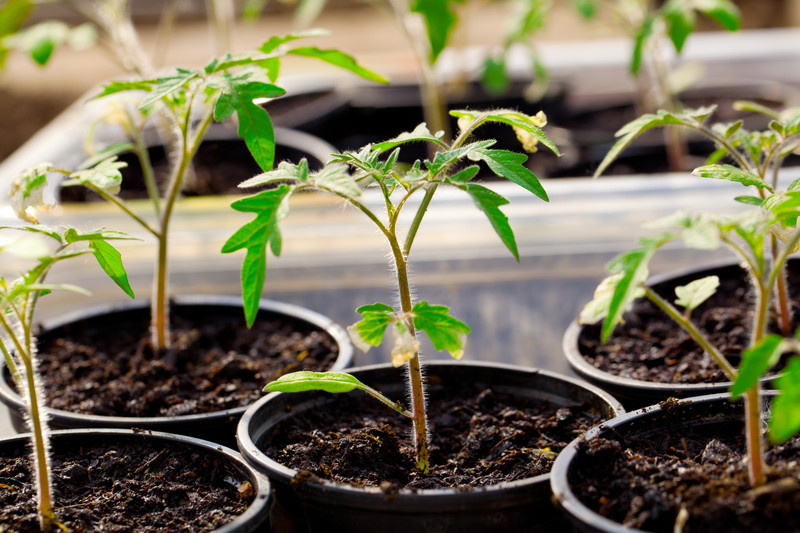
Tomatoes
Tomato is a warm-season crop. Sow seeds indoors 6 to 8 weeks before the average date of the last frost in spring. Sow seeds ¼ inch deep in either cell packs or about 1 inch apart in flats. Seeds will germinate in 5 to 7 days at a soil temperature of 70°F to 75°. After seedlings emerge, keep the temperature no higher than 70°F. Feed seedlings once a week with diluted fish emulsion. When seedlings develop two to four true leaves, transplant them to individual 4-inch peat pots; set seedlings slightly deeper than they were before. Transplant seedlings to the garden when the danger of frost has passed and daytime temperatures are consistently warmer than 60°F. Set transplants at least 2 inches deeper in the soil than they were in the pots. Depending on the variety, tomatoes require 49 to 95 days to reach maturity after transplanting to the garden.
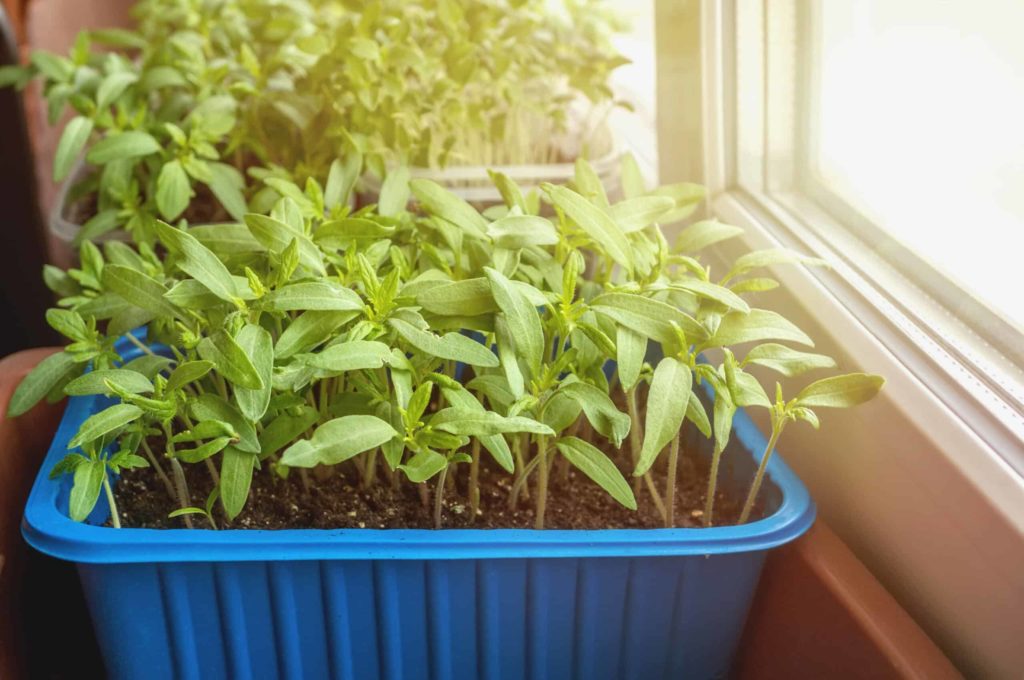
Indoor seed starting tips
If you know the average date of the last spring frost in your garden or region, you can make a schedule for starting vegetable crops indoors and get growing weeks before the outdoor temperatures warm. (Check at your local library or the county cooperative extension if you are unsure of the average last frost date.)
Here is a list of vegetables that are commonly started indoors and later transplanted into the garden:
Here are succession-cropping suggestions that might work in your region:
| Crops | Tips for seed starting |
|---|---|
| Onions, leeks: bulb-forming leeks and sweet Spanish and Bermuda onions require a long growing season to reach maturity, so give them a good head start. Bunching onions are ready in 55 days, dry onions in 100 days; leeks in 130 days. | Start indoors 10 to 12 weeks before the last frost: Seed germinates best at 65°F but will germinate at any temperature between 45° and 85°F. Start seed in the fall in warm-winter regions or where spring turns to summer quickly.
|
| Early tomatoes: push the season with cold and cool weather tolerant varieties; early tomatoes reach maturity in as little as 55 days from transplanting into the garden. | Start indoors 10 to 12 weeks before the last frost: Tomatoes need plenty of time to develop strong root systems. Grow on seedlings indoors at 75°F day and 65°F night to as low as 50°F night to prepare for early transplanting. Protect seedlings when they go into the garden: hot caps, baskets, and plastic or glass jugs. Warm garden soil with black plastic before transplanting.
|
| Celery: start indoors for spring crops; seeds for fall or winter crops are usually sown outside in spring. Allow 5 to 6 months for plants to reach harvest from seed. | Start indoors 8 to 10 weeks before the last frost: Frost resistant and can be set out while the weather is still cool. Do not expose seedlings to temperatures below 50°F for an extended period or they may bolt.
|
| Mid-season and late-season tomatoes: these tomatoes require from 70 to 110 days from transplanting to reach maturity. | Start indoors 6 to 8 weeks before the last frost: Seed germinates in 8 to 10 days at 70°F. For a long season, plant several varieties with differing days to maturity. |
| Early peppers: reach maturity in 70 to 90 days after transplanting. | Start indoors 6 to 8 weeks before the last frost: Grow on seedling at 65°F day and 55°F night. Set out transplants two weeks after the last frost when the soil has warmed; set in the garden two to three weeks earlier if plants are protected by cloche or plastic tunnel.
|
| Eggplant: reaches maturity in 90 to 125 days. | Start indoors 6 to 8 weeks before the last frost: Seed germinates in 10 to 12 days at 70°F. Grow on seedlings at 65°F day and 55°F night. Do not set transplants in the garden without protection until the daily temperature stays above 65°F; set out earlier under hot caps or cloches, Use deep mulch to protect seedlings in the garden from wind.
|
| All other peppers | Start indoors 4 to 6 weeks before the last frost: Grow on seedling at 65°F day and 55°F night. Transplant to garden two weeks after the last frost. |
| Cabbage: transplant to the garden a week or two before the average last frost date allowing this cool-weather crop to reach maturity before warm weather arrives. Reaches maturity in 65 to 125 days. | Start indoors 4 to 6 weeks before the last frost: Germinates quickly at 70° to 75°F started indoors. Grow on seedlings at 65°F day and 55°F night. Frost resistant and can be set out while the weather is still cool but after the last severe freeze.
|
| Cauliflower: transplant to the garden a week or two before the average last frost date allowing this cool-weather crop to reach maturity before warm weather arrives. Reaches maturity in 90 to 150 days. | Start indoors 4 to 6 weeks before the last frost: Germinates in 7 to 9 days at 70° to 75°F started indoors. Grow on seedlings at 65°F day and 55°F night. Frost resistant and can be set out while the weather is still cool. Spring crops must mature before hot weather; fall crops must mature before the first fall frost.
|
| Broccoli: transplant to the garden a week or two before the average last frost date allowing this cool-weather crop to reach maturity before warm weather arrives. Reaches maturity in 65 to 100 days. | Start indoors 4 to 6 weeks before the last frost: Germinates quickly at 70° to 75°F started indoors. Grow on seedlings at 65°F day and 55°F night. Frost resistant and can be set out while the weather is still cool. For a fall crop, sow seed in the garden in midsummer.
|
| Head lettuce: unlike loose-leaf lettuce, head lettuce needs more time–80 to 90 days―in cool weather to form a firm head. | Start indoors 3 to 4 weeks before the last frost: Germinates in 6 to 8 days at 65°F. Great Lakes is a popular home garden head variety. If the weather turns hot, heads will not form; start in fall in warm-winter regions.
|
| Melons and cucumbers: these crops are transplanted to the garden small while there is less risk of disturbing their sensitive roots. | Start indoors 3 to 4 weeks before the last frost: Time melon sowing so that the plant is set outside when the soil temperature has risen to 50°F nights and near 80°F days. Cucumber seed germinates indoors in less than 3 days with bottom heat of 80°F; grow on seedlings at temperatures not less than 65°F. Set transplants in the garden when melon and cucumber starts have no more than 4 leaves to avoid disturbing developing roots.
|
Related articles:
Seed Starting & Propagation Learning Hub
Start here — Seed Starting Basics: A Complete Beginner-to-Advanced Guide for Indoor and Outdoor Seed Starting
Seed Starting Fundamentals
- Seed Starting Guide
- Starting Plants from Seed
- Vegetable Seed Starting Indoors and Out
- How to Start Seeds Indoors Step-by-Step
- Starting Vegetables Indoors: 15 Varieties for Success
- Vegetable Seed Germination
- How to Read a Seed Packet
Planning & Timing
- Seed Starting Calendar: When to Start Seeds Indoors and Outdoors
- Spring Outdoor Seed Sowing Schedule
- Seed Catalog Guide: How to Choose the Best Seeds for Your Garden
- Vegetable Seed Buyer’s Guide
Seed Starting Tools, Supplies & Setup
- Essential Seed Starting Supplies
- Seed Starting Mix Buyer’s Guide
- How to Make Your Own Seed Starting Mix
- Seed Starting Tray Buyer’s Guide
- Peat Pot Buyer’s Guide
- Seedling Heat Mat Buyer’s Guide
- Best Lights for Starting Seeds Indoors (and How to Use Them for Strong, Compact Seedlings)
- Lights to Grow Plants: Choose the Right Light
Seedling Care, Troubleshooting & Success Tips
- Troubleshooting Seed Starting Problems: Leggy Seedlings, Damping Off, Weak Growth, and More
- How to Avoid Leggy Seedlings When Starting Indoors Under Lights
- Seed and Seedling Failure Troubleshooting
- Vegetable Seedling Protection
- How to Thin Vegetable Seedlings
Garden Planning Books at Amazon:

